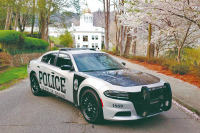Blazing a trail: Work starts on first Bartram Trail addition since the 1990s
 It’s been nearly 20 years since Burt Kornegay first started looking into land along Hickory Knoll Road in Macon County, but dirt is finally moving on the Bartram Trail Society’s vision of routing a piece of the long-distance trail away from the road and over the Pinnacle and George Gray Mountain instead.
It’s been nearly 20 years since Burt Kornegay first started looking into land along Hickory Knoll Road in Macon County, but dirt is finally moving on the Bartram Trail Society’s vision of routing a piece of the long-distance trail away from the road and over the Pinnacle and George Gray Mountain instead.
“This had been years in the making,” said Kornegay, who was in the midst of his 12 years as president of the Bartram Trail Society when he bought the land. “This was going on even before these tracts of land came up.”
One of the tracts in question is a 3-acre parcel that came on the market in the 1990s, just as the North Carolina Bartram Trail Society was mulling over how to reroute the trail while avoiding the pieces of private land abutting Nantahala National Forest.
“Knowing that land probably would sell quickly, my wife and I got together and decided if everybody on the board would agree that the Bartram Trail Society would pay us back, she and I would go ahead and buy it immediately to secure it,” Kornegay said.
They did just that, but the Society would need more than 3 acres to make its vision come true.
Enter a mysterious 10-acre property in the same neighborhood. Connecting two sections of national forest, acquiring it would be a coup for the project, so Kornegay and Richard Melvin, an attorney and Bartram Trail Society member, tried to figure out who owned it.
Related Items
Nobody, it turned out.
After a little research, they found that the last owner was Nimrod Jarrett, a notable Macon County landowner in his day. But his day ended long ago; Jarrett died in 1871. No heirs could be located, so with Melvin’s help Kornegay put in a quitclaim deed on the land, selling it to the Bartram Trail Society for a pittance. After holding onto the land for years and advertising the quitclaim deed in local newspapers, the Society was finally able to sell the property to the U.S. Forest Service and move forward with plans for trail construction.
Now, a contract has been awarded to Virginia-based High Country Conservation, and work began in January, with an expected completion date in summer 2016. A $75,000 grant from the 2012 Federal Recreational Trails Program and $19,000 from the Bartram Trail Society will cover the cost, with the Forest Service overseeing the project.
The Bartram Trail will still include about 10 miles of roadside hiking — though all but one of those miles are navigable by canoe on the Little Tennessee River — but those miles primarily traverse developed private land through which it would be near impossible to route a trail. The new section will eliminate some of those roadside miles and give hikers access to new views and special plant communities.
“It’s going through a pretty diverse piece of territory,” said Dan Pittillo, a founder of the Bartram Trail and retired Western Carolina University botany professor. “That whole ridge through there maintains a pretty high diversity of plants that we don’t have very much of in the region.”
Pittillo likes to be vague about the exact species so over-curious visitors won’t damage them, but he said species such as monkshood and packera millefolium give a strong showing. Trail planners took care to route the trail away from sensitive plants as much as possible, Pittillo said.
“We don’t want people to abuse them, and what we try to do is keep the trail as far away from getting into a rare plant habitat as we can,” he said.
That’s why the new trail section reaches few of the bare-rock cliffs that define the Fishhawks, because those cliffs also tend to house a high number of rare plants. However, the hike does feature one fantastic view, Pittillo said. From Cedar Cliffs, a view of Tessentee Valley unfolds below, looking over toward Clayton, Georgia.
Another view, located slightly off of the main trail, has special meaning to Kornegay. When he opened up his updated map of the Bartram Trail, he found a spot near the new section named Kornegay Point, a nod to the work he and Becky did to bring the project to fruition.
“We’d never seen it before, so this fall we hiked out there just to see,” Kornegay said. “It was quite impressive.”
It’s an adjective that applies to most of the Bartram Trail’s 80 North Carolina miles route, Kornegay said. From the Fishhawks to the Nantahala to the Cheoah mountains, the ridgetop views are plentiful and the backcountry is little traveled.
“It’s a trail that is similar to the Appalachian Trail in terms of being mainly a ridgetop trail, but it’s much less hiked,” Kornegay said. “I like that.”
So would have William Bartram, the 18th century naturalist for whom the trail was named.
“Everywhere he looked he didn’t see the beginning of a new town or a place for a railroad to go,” Kornegay said. “He liked primitive nature. And he liked the native inhabitants in this place, the Cherokee.”
Getting this new section done and ready for exploration takes the Bartram Trail Society one step closer its ultimate goal, Kornegay said: “to encourage that kind of appreciation of nature and the appreciation for the Cherokee culture that was here when Bartram was here.”









